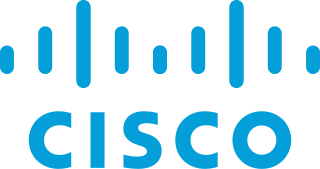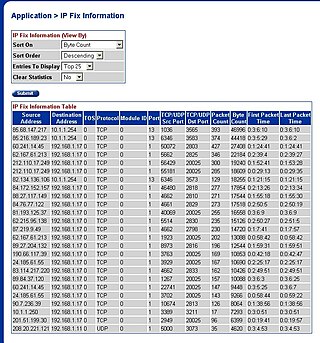
A wide area network (WAN) is a telecommunications network that extends over a large geographic area. Wide area networks are often established with leased telecommunication circuits.
A network switch is networking hardware that connects devices on a computer network by using packet switching to receive and forward data to the destination device.

Cisco Systems, Inc.,, is an American multinational digital communications technology conglomerate corporation headquartered in San Jose, California. Cisco develops, manufactures, and sells networking hardware, software, telecommunications equipment and other high-technology services and products. Cisco specializes in specific tech markets, such as the Internet of things (IoT), domain security, videoconferencing, and energy management with leading products including Webex, OpenDNS, Jabber, Duo Security, Silicon One, and Jasper. Cisco is one of the largest technology companies in the world, ranking 82nd on the Fortune 100 with over $51 billion in revenue and nearly 83,300 employees.
Cisco PIX was a popular IP firewall and network address translation (NAT) appliance. It was one of the first products in this market segment.

Catalyst is the brand for a variety of network switches, wireless controllers, and wireless access points sold by Cisco Systems. While commonly associated with Ethernet switches, a number of different types of network interfaces have been available throughout the history of the brand. Cisco acquired several different companies and rebranded their products as different versions of the Catalyst product line. The original Catalyst 5000 and 6000 series were based on technology acquired from Crescendo Communications. The 1700, 1900, and 2800 series Catalysts came from Grand Junction Networks, and the Catalyst 3000 series came from Kalpana in 1994.

EtherChannel is a port link aggregation technology or port-channel architecture used primarily on Cisco switches. It allows grouping of several physical Ethernet links to create one logical Ethernet link for the purpose of providing fault-tolerance and high-speed links between switches, routers and servers. An EtherChannel can be created from between two and eight active Fast, Gigabit or 10-Gigabit Ethernet ports, with an additional one to eight inactive (failover) ports which become active as the other active ports fail. EtherChannel is primarily used in the backbone network, but can also be used to connect end user machines.
A VLAN access control list (VACL) provides access control for all packets that are bridged within a VLAN or that are routed into or out of a VLAN. Unlike regular Cisco IOS access control lists that are configured on router interfaces and applied on routed packets only, VACLs apply to all packets. The technology was developed by Cisco on the Catalyst 6500 Series switch platform.
Port Aggregation Protocol (PAgP) is a Cisco Systems proprietary networking protocol, which is used for the automated, link aggregation of Ethernet switch ports, known as an EtherChannel. PAgP is proprietary to Cisco Systems. A similar protocol known as Link Aggregation Control Protocol (LACP) — released by the IEEE — is an industry standard and is not tied to a specific vendor.

The Cisco Catalyst 6500 is a modular chassis network switch manufactured by Cisco Systems from 1999 to 2015, capable of delivering speeds of up to "400 million packets per second".

The Cisco Catalyst 1900 is a 19" rack mountable, managed (configurable) 10BASE-T Ethernet switch with 100BASE-TX/100BASE-FX uplink ports. This product was popular in small office networks because of its features and price.
InterSwitch Trunk (IST) is one or more parallel point-to-point links that connect two switches together to create a single logical switch. The IST allows the two switches to share addressing information, forwarding tables, and state information, permitting rapid fault detection and forwarding path modification. The link may have different names depending on the vendor. For example, Brocade calls this an Inter-Chassis Link (ICL). Cisco calls this a VSL.

The Ethernet Routing Switch 5500 Series or is a series of stackable, Layer 3 switches used in computer networking. The ERS 5000 was originally designed by Nortel and is now manufactured by Avaya. Up to 8 ERS 5000 Series Switches may be stacked in a 640 Gbit/s fast stacking configuration. This Switch was used as the access layer device for the 2010 Winter Olympics games. The 817 Access Switches supported 8782 Voice-over-IP telephones.
Web Cache Communication Protocol (WCCP) is a Cisco-developed content-routing protocol that provides a mechanism to redirect traffic flows in real-time. It has built-in load balancing, scaling, fault tolerance, and service-assurance (failsafe) mechanisms. Cisco IOS Release 12.1 and later releases allow the use of either Version 1 (WCCPv1) or Version 2 (WCCPv2) of the protocol.
The Cisco Nexus series switches are modular and fixed port network switches designed for the data center. Cisco Systems introduced the Nexus Series of switches on January 28, 2008. The first chassis in the Nexus 7000 family is a 10-slot chassis with two supervisor engine slots and eight I/O module slots at the front, as well as five crossbar switch fabric modules at the rear. Beside the Nexus 7000 there are also other models in the Nexus range.
TRILL is an Internet Standard implemented by devices called TRILL switches. TRILL combines techniques from bridging and routing, and is the application of link-state routing to the VLAN-aware customer-bridging problem. Routing bridges (RBridges) are compatible with and can incrementally replace previous IEEE 802.1 customer bridges. TRILL Switches are also compatible with IPv4 and IPv6, routers and end systems. They are invisible to current IP routers, and like conventional routers, RBridges terminate the broadcast, unknown-unicast and multicast traffic of DIX Ethernet and the frames of IEEE 802.2 LLC including the bridge protocol data units of the Spanning Tree Protocol.
The Cisco Aggregation Services Router (ASR) series of routers are modular routers produced by Cisco Systems. The highest end of the lineup, the ASR 9000 series, is intended for service provider (SP) core networks.
Hewlett Packard Enterprise Networking is the Networking Products division of Hewlett Packard Enterprise. HPE Networking and its predecessor entities have developed and sold networking products since 1979. Currently, it offers networking and switching products for small and medium sized businesses through its wholly owned subsidiary Aruba Networks. Prior to 2015, the entity within HP which offered networking products was called HP Networking.
IOS XE is a release train of Cisco Systems' widely deployed Internetworking Operating System (IOS), introduced with the ASR 1000 series.
A modular switch or chassis switch is a type of network switch which can be configured using field-replaceable units. These units, often referred to as blades, can add more ports, bandwidth, and capabilities to a switch. These blades can be heterogenous, and this allows for a network based on multiple different protocols and cable types. Blades can typically be configured in a parallel or failover configuration, which can allow for higher bandwidth, or redundancy in the event of failure. Modular switches also typically support hot-swap of switch modules, this can be very important in managing downtime. Modular switches also support additional line cards which can provide new functions to the switch that would previously have been unavailable, such as a firewall. An example of a modular computer network switch is the Cisco Catalyst 6500, which can be configured with up to 13 slots, and supports connections from RJ45 to QSFP+.





